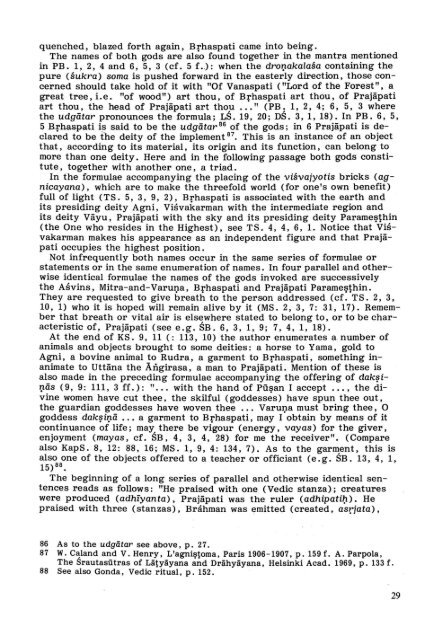Prajapati's relations with Brahman, Brhaspati and Brahma - DWC
Prajapati's relations with Brahman, Brhaspati and Brahma - DWC
Prajapati's relations with Brahman, Brhaspati and Brahma - DWC
You also want an ePaper? Increase the reach of your titles
YUMPU automatically turns print PDFs into web optimized ePapers that Google loves.
quenched, blazed forth again, <strong>Brhaspati</strong> came into being.<br />
The names of both gods are also found together in the mantra mentioned<br />
in PB. 1, 2, 4 <strong>and</strong> 6, 5, 3 (cf. 5 f.): when the droQ.akalasa containing the<br />
pure (sukra) soma is pushed forward in the easterly direction, those concerned<br />
should take hold of it <strong>with</strong> "Of Vanaspati ("Lord of the Forest", a<br />
great tree, i. e. "of wood") art thou, of <strong>Brhaspati</strong> art thou, of Prajäpati<br />
art thou, the head of Prajäpati art thou ... " (PB. 1, 2, 4; 6, 5, 3 where<br />
the udgätar pronounces the formula; LS. 19,20; DS. 3,1,18). In PB. 6, 5,<br />
5 Rrhaspati is said to be the udgätar 86 of the gods; in 6 Prajäpati is declared<br />
to be the deity of the implement 87. This is an instance of an object<br />
that, according to its material , its origin <strong>and</strong> its function , can belong to<br />
more than one deity. Here <strong>and</strong> in the following passage both gods constitute,<br />
together <strong>with</strong> another one, a triad.<br />
In the formulae accompanying the placing of the visvajyotis bricks (agnicayana),<br />
which are to make the threefold world (for one's own benefit)<br />
full of light (TS. 5,3,9,2), <strong>Brhaspati</strong> is associated <strong>with</strong> the earth <strong>and</strong><br />
its presiding deity Agni, Visvakarman <strong>with</strong> the intermediate region <strong>and</strong><br />
its deity Väyu, Prajäpati <strong>with</strong> the sky <strong>and</strong> its presiding deity Parame!?thin<br />
(the One who resides in the Highest) , see TS. 4, 4, 6, 1. Notice that Visvakarman<br />
makes his appearance as an independent figure <strong>and</strong> that Prajäpati<br />
occupies the highest position.<br />
Not infrequently both names occur in the same series of formulae or<br />
statements or in the same enumeration of names. In four parallel <strong>and</strong> otherwise<br />
identical formulae the names of the gods invoked are successively<br />
the Asvins, Mitra-<strong>and</strong>-Varul}.a, <strong>Brhaspati</strong> <strong>and</strong> Prajäpati Parame!?thin.<br />
They are requested to give breath to the person addressed (cf. T S. 2, 3,<br />
10, 1) who it is hoped will remain alive by it (MS. 2, 3, 7: 31, 17). Remember<br />
that breath or vital air is elsewhere stated to belong to, or to be characteristic<br />
of, Prajäpati (see e. g. SB. 6, 3, 1, 9; 7, 4, 1, 18).<br />
At the end of KS. 9, 11 (: 113, 10) the author enumerates a number of<br />
animals <strong>and</strong> objects brought to some deities : a horse to Yama, gold to<br />
Agni, a bovine animal to Rudra, a garment to <strong>Brhaspati</strong>, something inanimate<br />
to Uttäna the Ängirasa, a man to Prajäpati. Mention of these is<br />
also made in the preceding formulae accompanying the offering of dak~i<br />
Q.äs (9, 9: 111, 3 ff.): "... <strong>with</strong> the h<strong>and</strong> of l'ü!?an I accept ... , the divine<br />
women have cut thee, the skilful (goddesses) have spun thee out,<br />
the guardian goddesses have woven thee ... Varul}.a must bring thee, 0<br />
goddess dak~iQ.ä •.• a garment to <strong>Brhaspati</strong>, may I obtain by means of it<br />
continuanee of life; may, there be vigour (energy, vayas) for the giver,<br />
enjoyment (mayas, cf. SB, 4, 3, 4, 28) for me the receiver". (Compare<br />
also KapS. 8, 12: 88, 16; MS. 1, 9, 4: 134,7). As to the garm,ent, this is<br />
also one of the objects offered to a teacher or officiant (e. g. SB. 13, 4, 1,<br />
15) 88.<br />
The beginning of a long series of parallel <strong>and</strong> otherwise identical sentences<br />
reads as follows: "He praised <strong>with</strong> one (Vedic stanza); creatures<br />
were produced (adhïyanta) , Prajäpati was the ruler (adhipati1). He<br />
praised <strong>with</strong> three (stanzas), Bráhman was emitted (created, asrjata),<br />
86 As to the udgätar see above, p. 27.<br />
87 W. C~l<strong>and</strong> <strong>and</strong> V. Henry, L'agnililtoma, Paris 1906-1907, p. 159 f. A. Parpola,<br />
The Srautasütras of Lätyäyana <strong>and</strong> Drähyäyana, Helsinki Acad. 1969, p. 133 f.<br />
88 See also Gonda, Vedic ritual, p. 152.<br />
29
















